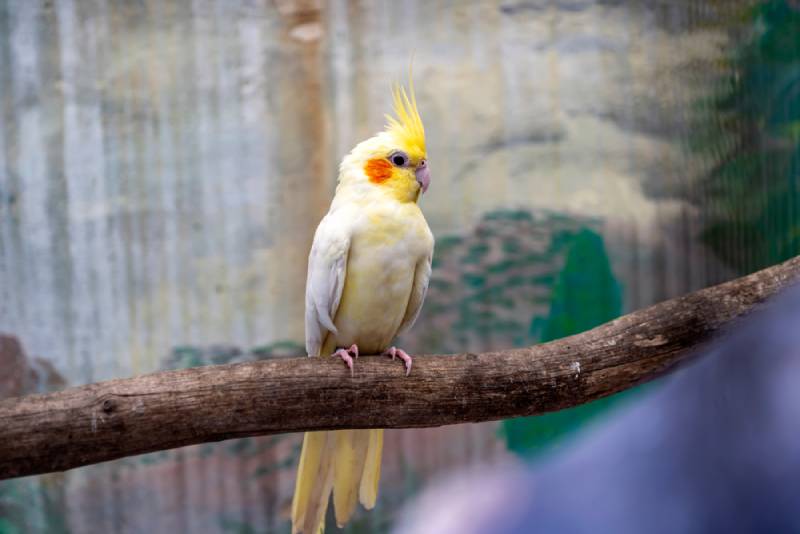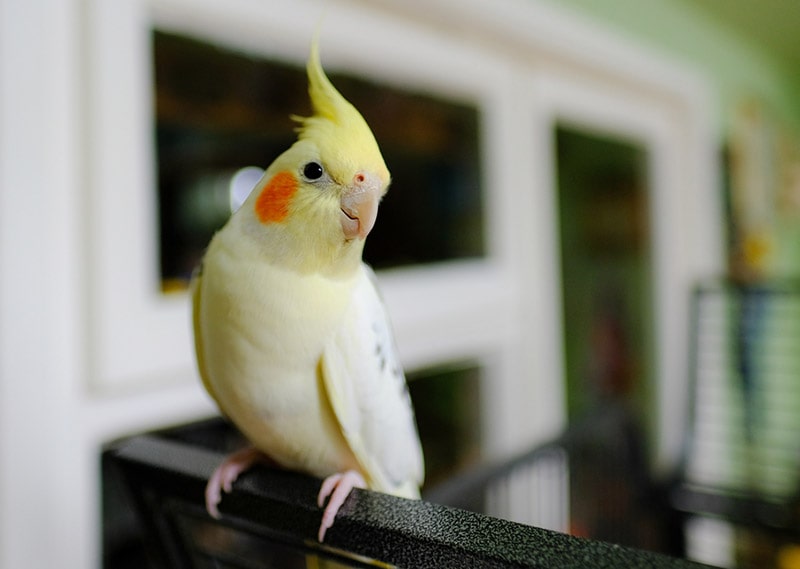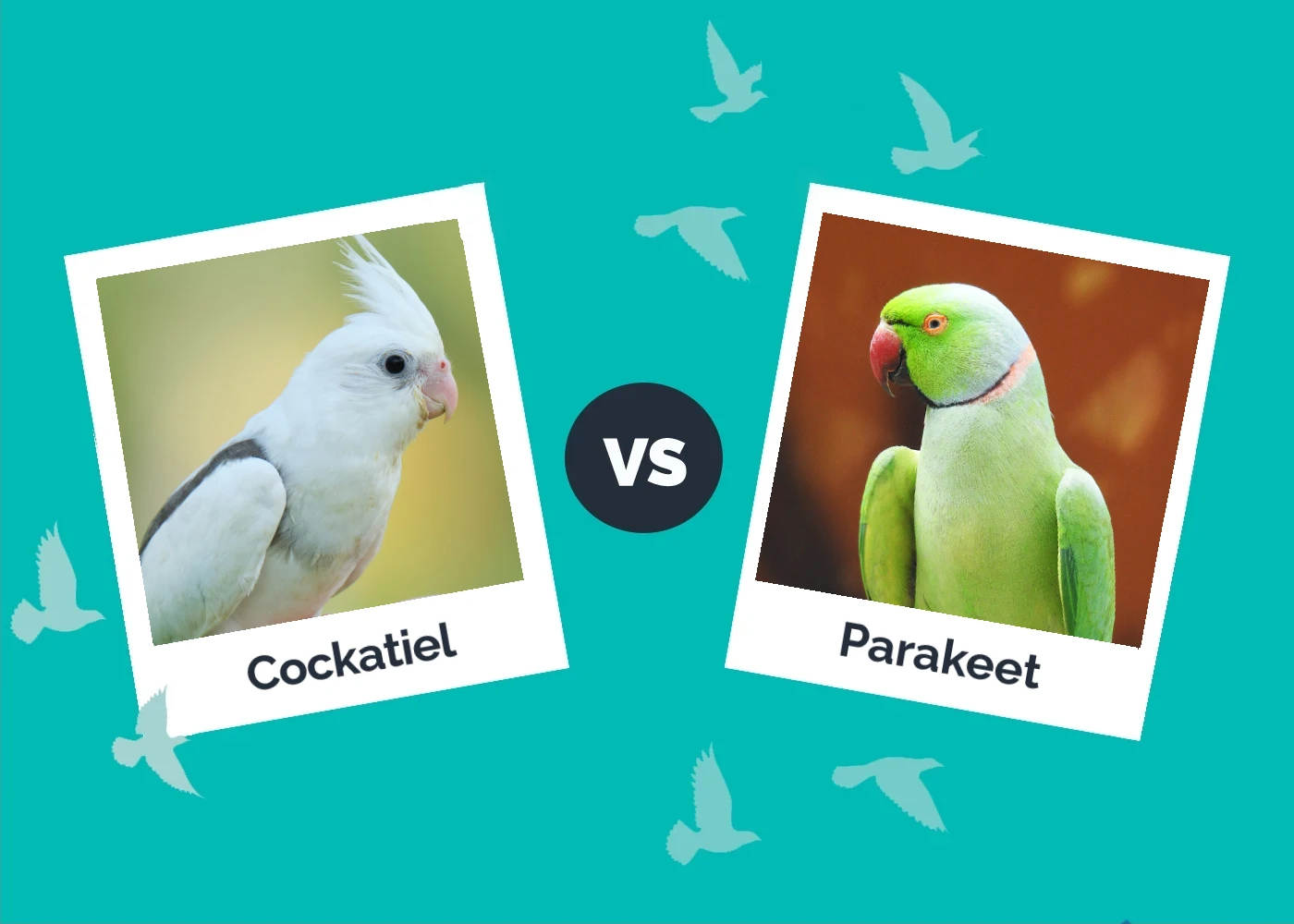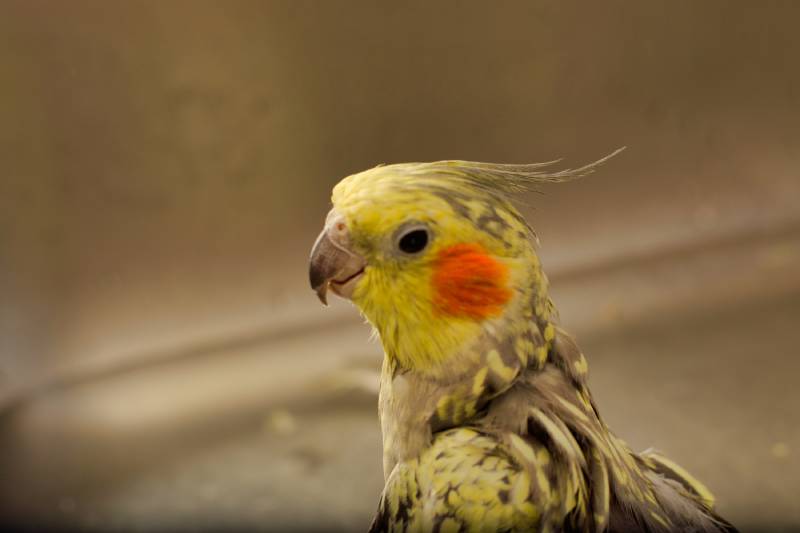Cinnamon Cockatiel: Pictures, Facts, & History

Updated on

Click to Skip Ahead
The Cinnamon Cockatiel is a color variant of the Standard or Gray Cockatiel. It has a cinnamon or light brown tinge to its otherwise gray feathers. The Cinnamon also has more yellow feathers on its chest and brown around its eyes and on its feet and legs. The brown in the plumage can vary from subtle cinnamon to a darker, almost chocolate color.
The mutation does not affect the friendliness, hardiness, or other features of the Cockatiel that have made it one of the most popularly kept pets and certainly one of the most popular pet bird species.
| Height: | 12-14 inches |
| Weight: | 2-4 ounces |
| Lifespan: | 10–20 years |
| Colors: | Gray, yellow, brown, white, orange |
| Suitable for: | Novice to experienced owners looking for a friendly bird with unique coloring |
| Temperament: | Fun, friendly, hardy, playful |
The Cinnamon Cockatiel is not found in the wild and has been intentionally bred for its color mutation and variation. It has become a popular variant, and several variants of the Cinnamon Cockatiel now exist, with the Cinnamon Pearl Cockatiel proving especially popular. In this case, the cinnamon color is a gray color with a light brown tinge, but the actual depth and hue of brown can vary from light brown to very dark.
The cinnamon mutation is a sex-linked mutation, which means that it is part of the sex chromosome. The breeding of birds with sex-linked mutations is best left to expert breeders because it can raise chick mortality rates and yield mixed results.
Cinnamon Cockatiel Breed Characteristics
The Earliest Records of Cinnamon Cockatiels in History
Cockatiels are native to most of mainland Australia, where all wild examples have the traditional gray, yellow, and orange markings. They are members of the Cockatoo family. They have become very popular as pets because they are relatively low maintenance, tolerate and even enjoy handling, and are hardy birds that can cope with changes in their environment and living conditions without becoming too stressed. All pet Cockatiels are captive-bred because the export of the birds from Australia has been banned.
The Cinnamon Cockatiel, specifically, was bred in Belgium in 1967, by Mr. Van Otterdijk. The gene mutation of the Cinnamon does not change the amount of pigment or color, but melanin production is reduced which means that feathers and other parts of the bird are prevented from turning black or gray.

How Cinnamon Cockatiels Gained Popularity
As well as being prevalent in the wild, Cockatiels proved easy to breed in captivity, which helped make them a popular pet bird species starting in the early 1900s. Their friendly personality and docile nature meant that they could be handled by owners and they were considered easy to care for, which served to enhance their pet popularity. In 1894, the export of Cockatiels from Australia was outlawed by the Australian government and while some illegal exports may have continued after this time, all pet Cockatiels today are captive-bred and originate outside Australia. This captive breeding has seen the Cockatiel become even more docile and it means that pet Cockatiels love their humans and interact well with family.
The Cinnamon Cockatiel is one of several variants of the Cockatiel that have emerged as breeders and owners look for unique and unusual variations of the bird. Popular variants include the Lutino and the Pied Cockatiel, although the Cinnamon Cockatiel is becoming a popular option, too.
Formal Recognition of Cinnamon Cockatiels
Cockatiels aren’t formally recognized or registered in the same way as pedigree cats and dogs, so there is no formal recognition of Cinnamon Cockatiels. However, this is a popular color variant and one that is widely recognized by breeders, clubs, and owners. Therefore, you can find breeders of this particular type of Cockatiel, and you may also be able to find them in some pet and bird stores.
The 5 Unique Facts About Cinnamon Cockatiels
1. It Is Also Known As the Isabelle Cockatiel
As well as being called Cinnamon Cockatiels, this variant may also be called Cinnamon ‘Tiels, with ‘tiel being a common nickname that is just a shortened version of Cockatiel. They are also sometimes called Isabelle Cockatiels.

2. The Mutation Also Affects the Eyes, Beak, Feet, and Legs
The main effect of the Cinnamon color mutation is that it prevents the formation of melanin. Melanin is what gives Cockatiels their gray feathers but also other gray and black markings. Subsequently, Cinnamon Cockatiels often have brown pupils, rather than black, and their feet and legs, as well as their beaks, may also be brown.
3. They Cost Around the Same As a Gray Cockatiel
The Cinnamon Cockatiel is a popular color variant but that doesn’t mean that it carries a prohibitive price tag. Typically, they are available for around the same price as a Gray Cockatiel. Some variants, like Cinnamon Pearl Cockatiels, may cost more.
4. Some Cockatiels Can Learn to Talk
Although rare, some Cockatiels will learn to mimic a few human words. This is more likely in males, as is true of most speaking birds. Generally, however, Cockatiels are known for whistling and they may imitate other noises they hear. A scared Cockatiel can hiss, and you can hear a variety of other noises from this little bird.
5. They Can Be Dusty
Cockatiels can make a bit of a mess. They may flick their food out of their cage, and you will always have to be ready to hunt down bird poo in any room the bird is allowed to fly. Cockatiels are also known for producing dust. This dust is similar to the dander produced by dogs and cats, and it is naturally forming and cast off the feathers when the bird flies, flaps, or preens itself.
Does a Cinnamon Cockatiel Make a Good Pet?
Regardless of its color or markings, the Cinnamon Cockatiel is a Cockatiel, and this species of bird has become a very popular pet because it is friendly and docile. With regular and careful handling, Cockatiels will not only tolerate being handled, but they will also enjoy it. Some pet Cockatiels enjoy spending time sitting on their owner’s hand, shoulder, or even their head. They are also fun and smart little birds, which means they can be taught a few simple tricks with some training. Unfortunately, this doesn’t include toilet training, and your Cockatiel will likely poop wherever it needs to.
The Cockatiel does need a decent-sized cage so that it can spread its wings and hop around. It will also need to be let out of its cage for some free flight, every day. So, while they do make great pets, Cockatiels also need some time and attention. If they don’t get this companionship, they can develop behavioral issues and become difficult pets.
Conclusion
Cockatiels are considered great first-time birds and they make very good pets, as long as owners are willing to put some time and effort into their care and companionship. The Cinnamon Cockatiel is a color variant that has cinnamon gray feathers as well as brown feet, beaks, legs, and eyes. The mutation does not affect the health or other aspects of the bird, and it is becoming a popular color mutation with fans of the Cockatiel species.
Featured Image Credit: Barbara Rost, Shutterstock











